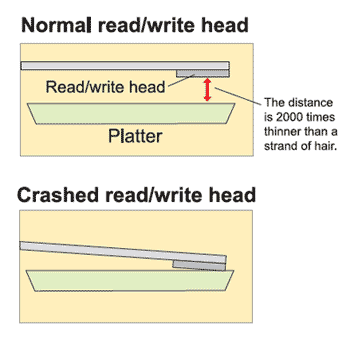| Storage Media | Hard Disks | DVD Disc | |||
| Optical Discs | Tape Media | Flash Drive | |||
| Zip Catridges | RAID | Removable Media | |||
| (U)niversal (B)us (S)erial |
Related Hard Disks Topics
| How Hard Disk Works? | Hard Disk Parts and FAT | Hard Disk Myths | MTBF of a Disk Drive | ||||
| Password Security Lock | S.M.A.R.T | Upgrade Your Hard Disk | Hard Disk Crash |
Hard Disk Crash
 |
What is a head crash in a hard disk drive?
In a nutshell, a head crash is a physical damage of a hard disk when the faulty electronic or mechanism causes the read-write head to land on the rotating platter instead of retracting to its safe zone, hence by damaging and grinding away the magnetic film on the disk surface.
What is a read-write head ?
A read-write head or simply the head, is a tiny electromagnet suspended by an armature that is precisely positioned above every disk platter.
The head acts as an interface between the physical storage media and the rest of the electronic components of the disk by transforming electrical signals into magnetic pulses to store data onto a disk.
In reverse, it reads the patterns of the magnetic flux and converts them into electrical signals which are further encoded into binary bits to be processed by the computer. See more on how hard disk works.
How does a head crash occur?
When the platter is rotating at rates between 5,400 to 15,000 revolutions per minute, a thin firm of air suspends the read/write head extremely closely above the disk surface.
This distance, called the head gap is typically measured in millionths of an inch. So, it is possible that heads can make contact with the media on the hard disk when there is faulty disk mechanism.
A. Bad Parking |
While the platter is idle, the head typically rests on the surface of the disk or on parking bay. When the disk powers up and the platter starts to spin, the head rubs along the surface of the platter briefly before a cushion of air is strong enough to hover the head above its surface. During a power down, the process is reversed till the platter finally stalls. Damage can likely set in after a prolonged period of wear and tear. Hence, a landing zone or an empty track was developed to set aside for the head to take-off and land. This safety process is known as the parking technology. Most modern disk that uses the voice-coil or giant magneto-resistive head, supports auto-parking. In an event of power loss to the disk, a retract mechanism moves and secures the head to its landing zone without the use of external power. It then automatically unparks itself when the disk powers up again. Another similar technique is the load/unload technology which uses a ramp-like mechanism to lift the head from the disk surface and park it outside of the platter. Older drives that do not support auto-parking use software utilities that execute head parking procedures before the computer shuts down. |
B. Dust Debris |
A hard disk is never 100% seal. If it is, then it is not possible to create the necessary air flow for the disk working mechanism. When dust enters and contaminates the hard disk, it can obstruct the movement of the head, resulting in a crash as the clearance between the the head and platter is by far smaller than the size of a smoke particle. |
C. Mechanical Shock |
A shock applied to a disk while it is in active state may cause the head to bounce and slide against the platter henceforth scratching it. |
D. Power Surge |
Another reason is the effect of using poor power supply which has the same problem as power surges and power cuts, resulting in unpredictable movement of read write head mechanism causing the crash. |
E. Wear & Tear |
Hard disks are complex and extremely delicate electro-mechanical devices that subjected to wear and tear over time. They have a fairly predictable lifespan even within a controlled environment, just like other mechanical devices. |
Protection Measures Against Hard Disk Crashes
With the advancement of technology, platters manufactured today are guarded with anti-vibration mechanism and head parking technology to prevent the head from making contact with the rotating platter when a drive is shocked or jostled.
Protective layers are also implemented on the magnetic surfaces of newer disks to withstand a certain amount of headcrash abuse before permanent damage sets in.
For instance, laptops computer hard disks are manufactured with better shock resistance capability as these machines are typically on the move. However it is always recommended to avoid moving your computer while the disk is still in operation.



